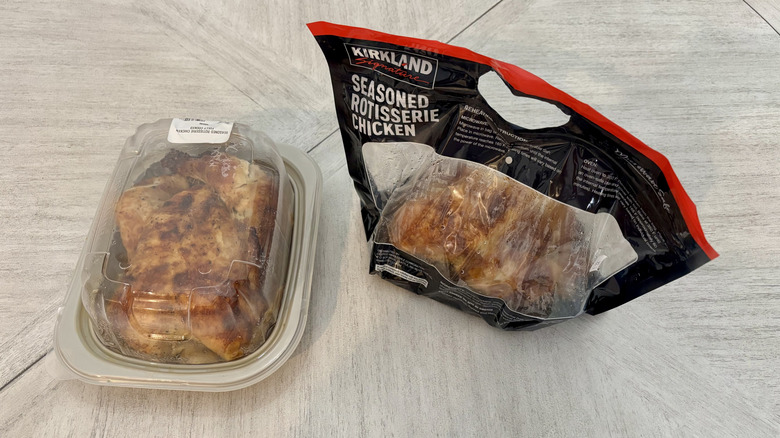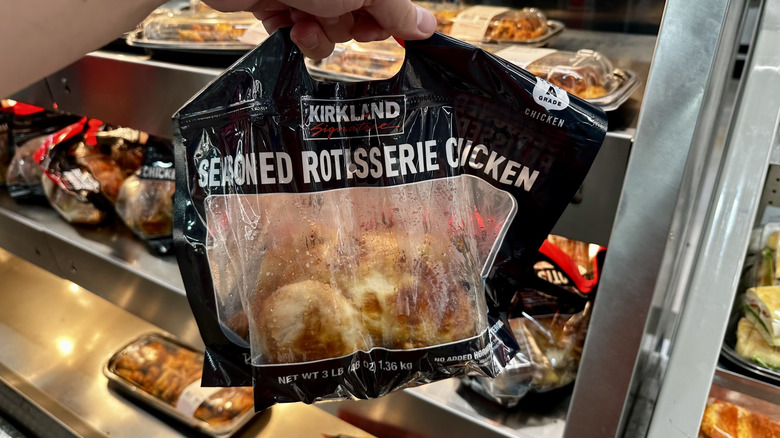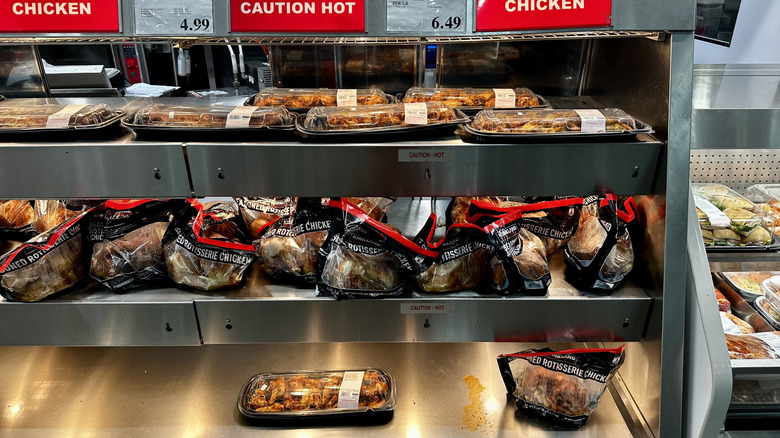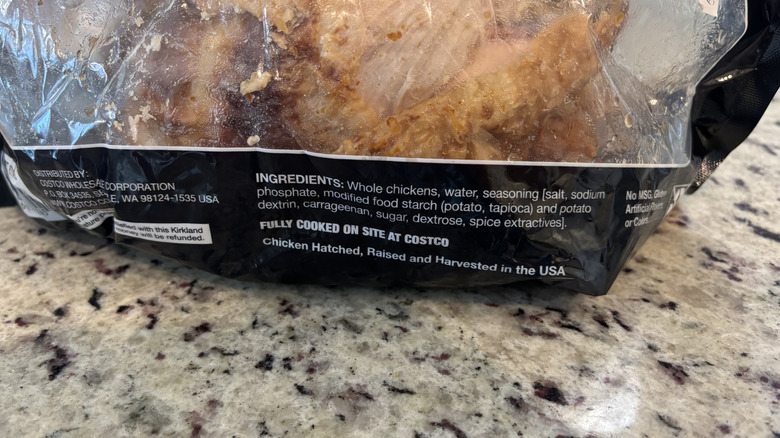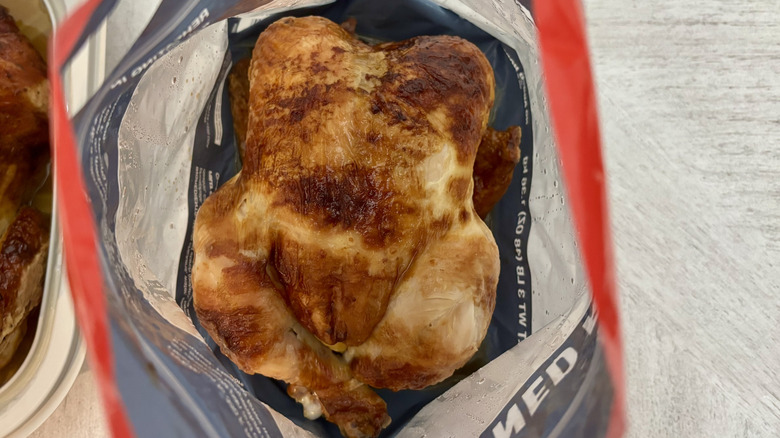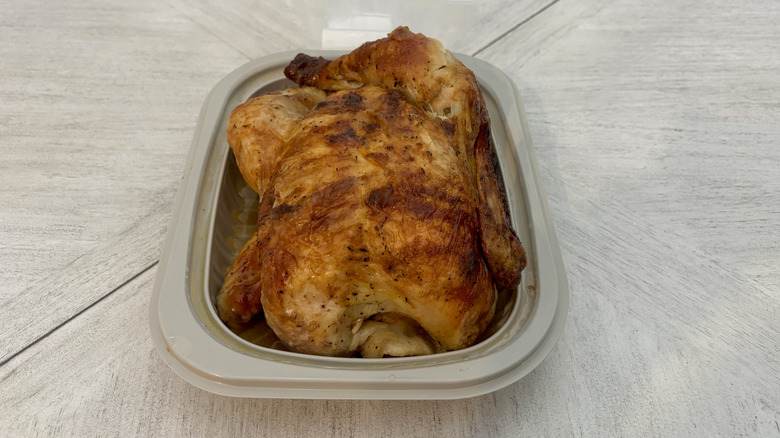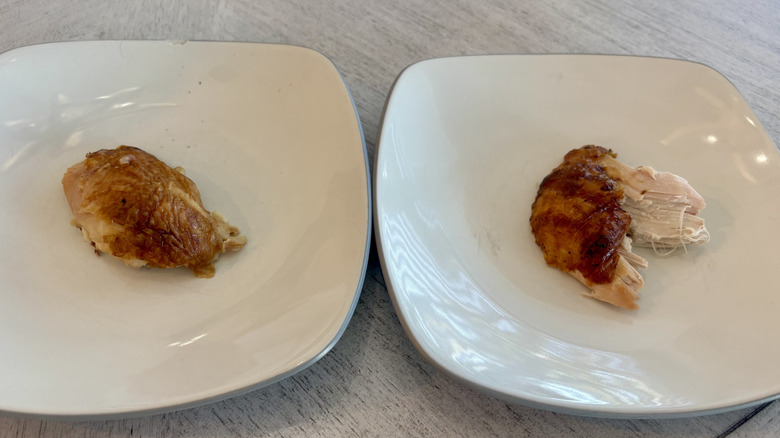Sam's Club Vs Costco: Which Rotisserie Chicken Tastes Better?
For quick meal prep, perhaps no item is more helpful than a grocery store rotisserie chicken. It saves you the time of roasting up your own chicken, and a rotisserie chicken is often much cheaper than making one fresh in your own oven.
As a new Costco member, I felt drawn to try the rotisserie chicken that takes up a huge swath of the deli toward the back of the store. I wondered if Costco would win out when compared to Sam's Club in a protein product bigger than the warehouse monsters' hot dogs.
To compare the two, I purchased a rotisserie chicken from each location. At Costco, I could do this in person, but my Sam's Club chicken came way of Instacart, as I do not have a membership with the club. Tasting each chicken and noting vital aspects like texture, juiciness, packaging, and flavors, I determined which of the two rotisserie chickens I believe is superior.
What is a grocery store rotisserie chicken?
All rotisserie chickens are roasted, but not all roasted chickens are rotisserie. The biggest difference is the movement of the chicken during the roasting process. Rotisserie chicken rotates around, cooking evenly throughout, but a roasted chicken, like a chicken you might prepare in your oven at home, gets put in a pan and then sits, stationary, in your oven. There is no constant rotation here.
At many grocery stores, you'll find rotisserie chickens in the deli. At some stores, like Walmart, Target, or Publix, these rotisserie chickens are made only a couple birds at a time. At larger warehouse stores like Sam's Club and Costco, rotisserie chickens are made on such a large scale, it's something of a spectacle to behold.
My family has been enjoying home-cooked roasted chicken with veggies as one of our go-to meals, and while it's delicious, especially when cooked with veggies in the pan, it's a long cook for a weeknight (or any night) of dinner. That's one of the reasons that a grocery store rotisserie chicken is just so beloved. There's no prep time, and you have dinner nearly ready as soon as you check out.
Availability and price
Rotisserie chickens from Costco and Sam's Club are something of a staple item. You'd be hard-pressed to visit either store without seeing each one with fully stocked warming shelves absolutely full of rotisserie chickens.
If you're a member at either location, you can get the chickens for their listed price. Costco's in-store rotisserie chicken price is $4.99. Not to be outdone, Sam's Club offers it for ever so slightly less, at $4.98, making it the cheaper of the two warehouse store rotisserie chickens.
While I am a Costco member, I am not a Sam's Club member, so I needed to order my Sam's Club chicken through Instacart. At my location, this meant I paid $6.32 for the chicken, more than a fourth as much more. If I weren't a Costco member, my price would have been higher there, too, at $6.21, slightly less than a fourth as much more.
Nutrition information and ingredients
Between the two rotisserie chickens, the nutritional differences aren't anything substantial. Both chickens come in at 140 calories with 7 grams of fat and 19 grams of protein. The only place they differ is in the sodium numbers. The Costco bird has 460 milligrams of sodium, and Sam's Club has 430 milligrams. The difference in your recommended daily intake is only 1%.
In terms of ingredients, there is slightly more variance. While the Costco bird has a simpler ingredient listing, it has one ingredient that may be a little concerning to some: carrageenan. Its intent is to thicken or even provide preservative quality to food. For some, it will be important to note that although the additive is very common, often in other meat products and even nut milks, it may have some concerning effects on your digestive system.
Taste test: Costco Rotisserie Chicken
Walking toward the back of Costco, you'll see a bakery, butcher, and deli space. Right in the middle of it all is a line of machines cooking up rotisserie chicken. If you're lucky enough, you'll witness associates bagging cooked chicken and placing it on the warmers before adding more skewered chickens to cook.
Costco's rotisserie chicken comes in a plastic bag. It is microwaveable to reheat leftovers, even though the bag really doesn't look hearty enough to be microwaved. In any case, you'll be lucky to have any leftovers of the chicken. Instead, I find this bag helpful for getting the chicken to fit in the refrigerator if I'm using it for a meal in the following couple of days.
When sampling, as I peeled the chicken off, I noticed the slight crunch of the skin, but the juiciness really stood out. There was a moistness to the meat that made it enjoyable to eat. Seasoning-wise, I thought it had an enjoyable flavor with seasoning that supported the chicken flavor rather than trying to cover it up. It was neither under or over seasoned but rather the perfect amount.
Taste test: Sam's Club Rotisserie Chicken
Since I don't have a Sam's Club membership, I ordered my rotisserie chicken through the Instacart app. As a result, I didn't get a firsthand view of how Sam's Club makes up the chicken, but rather found social media videos displaying the process. The process appears very similar, save one huge difference: Sam's Club uses a clam shell style plastic packaging. Both, however, had microwave reheating instructions printed right on the packaging.
If you want the most basic of basic chickens, you want Sam's Club chicken. I found that the seasoning was too mild on this one, and I was looking for more. That said, my Sam's Club bird was bigger than my Costco one, so while Sam's Club costs (slightly) less, you also get more. It's hard to say whether it's from the chicken sitting too long on warmers or simply the cooking of the chicken, but I noticed that the skin was splitting in lots of places, too.
Verdict: Which store has the better rotisserie chicken?
Between Costco and Sam's Club rotisserie chickens, I prefer the Costco offering, largely due to flavor. I recognize that the difference between the two chickens is minimal, but the seasoning of the Costco variety was tastier with a better texture. I also preferred the crispness of the skin. It rode that middle ground of being crispy without being too crunchy that can be hard to achieve. Sam's Club just had a very basic flavor comparatively. As different as it may be, I also find that the bag packaging is more enjoyable than the Sam's Club clam shell container.
At either location, you can choose your own rotisserie chicken off the warmer, and while you'll want to purchase the heaviest rotisserie chicken you can find, I recommend paying attention to when the chicken is put on the shelf. It's worth observing your store's process for a few minutes and acting fast when you see that new chicken is added to the shelves. This way, you can be sure that you are choosing a freshly cooked chicken.
I should state that while I ultimately enjoyed the Costco rotisserie more, I found it a great deal more surprising how similar the rotisserie chickens ended up being. For competitors, these two warehouse stores are very, very similar to one another. The differences are minimal, but when pressed, Costco comes ahead for me.
Methodology
I made my decision on which warehouse store offers the better rotisserie chicken based on the whole experience: flavor, texture of skin, juiciness of the chicken, how moist it was inside, and even the packaging. I wanted a chicken that was seasoned in a complementary, but not overwhelming, manner. The texture needed to offer a tenderness that was easy to enjoy without being too soft, and this often played a part in the chicken's juiciness and moistness, too.
Once I realized the packaging was different, I knew this needed to play a role, too. I wanted packaging that felt solid but also easily storable in a packed fridge. After all, if you're shopping at a warehouse store, storage is everything.

